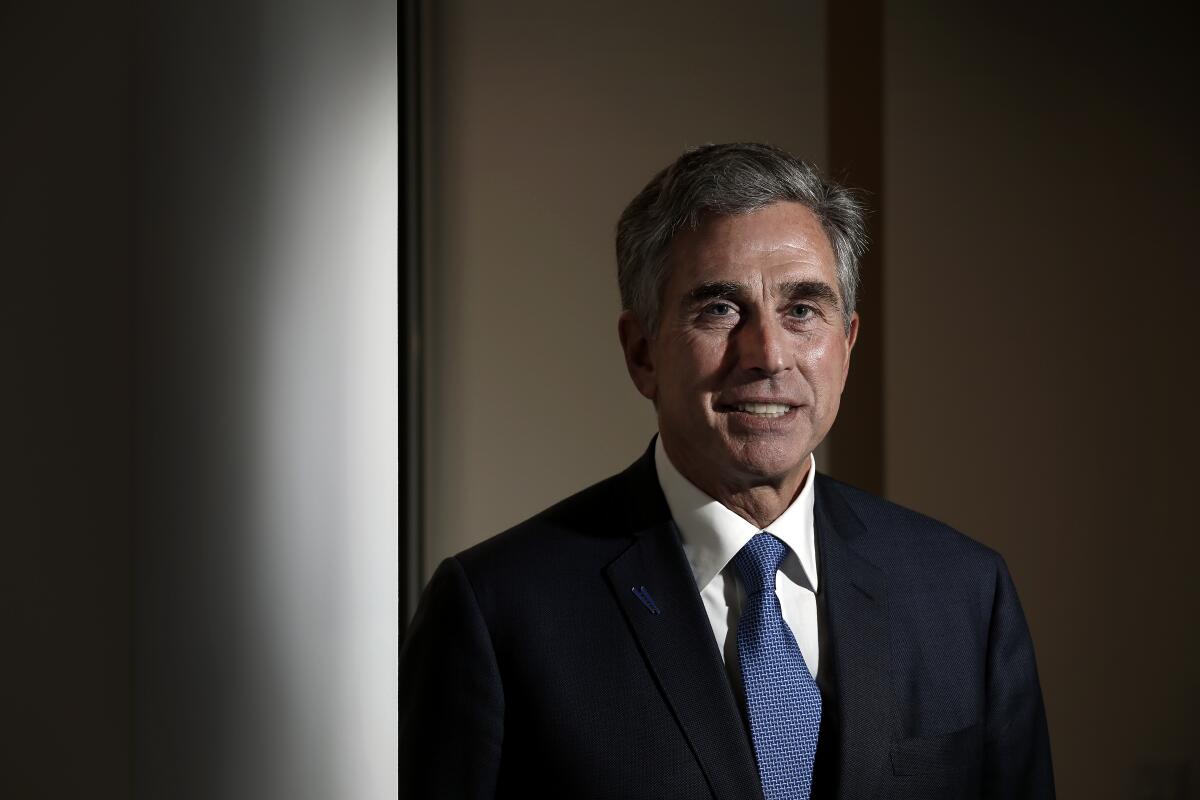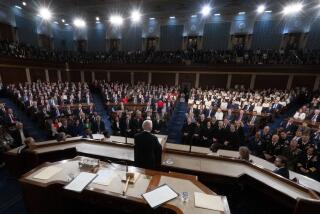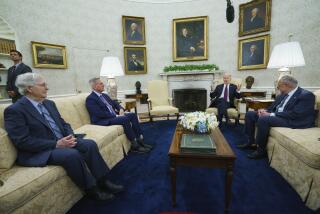This L.A. banker thinks the New Deal can point the way to recovery

- Share via
The damage to the U.S. economy from the coronavirus is devastating: 33 million unemployed and an expected drop in second-quarter gross domestic product of up to 40%. But there’s no consensus in Washington about how to fix it.
President Trump has tweeted for the elimination of payroll taxes, a possible capital gains cut and a big infrastructure package.
House Speaker Nancy Pelosi said Thursday the Democratic plan for the fourth stimulus package will focus on a bailout of state and local governments, funds for testing and direct cash assistance to individuals.
Some Republican voices have called for a pause after more than $2.5 trillion in stimulus spending so far, but Russell Goldsmith, 70, the dean of Los Angeles bankers, says now is not the time to hit the brakes.
The chairman and former chief executive of City National Bank got an upfront view of the nation’s last crisis while sitting on the Fed’s Federal Advisory Council from 2008 to 2011. He says that what the country needs is not just more relief but an economic recovery plan of up to $2 trillion that includes infrastructure, job retraining and other measures, inspired by New Deal programs such as the Civilian Conservation Corps.
The interview has been edited for brevity and clarity.
What were the lessons you drew from the government’s response to the Great Recession?
You are not going to flip a switch and everybody goes back to movie theaters and Dodger Stadium and restaurants. And in 2008-09 they never shut down the airlines, they never closed the restaurants, never turned off sports. So my central point would be that this so-called phase four bill ought to address expanded relief and bolt on to it a massive set of recovery efforts. Recovery as we learned in 2008-09 takes time to get going. You can get checks out pretty fast, but shovel-ready projects don’t start the next morning.
You talk about the need for traditional infrastructure, such as roads, bridges and mass transit, but also reallocating billions of dollars for public health.
We have to redefine what national security means and allocate federal resources in line with that new understanding. If more Americans can die in six weeks from a pandemic than die in Vietnam in a decade, surely fighting pandemics and protecting public health here in the homeland is a matter of national security. I would argue $750 billion for the Defense Department is a source, but whether you take the money out of Defense is not the issue. We clearly have to strengthen our public health system.
Is that really a matter of economic recovery?
We need more money for the Centers for Disease Control and Prevention and National Institutes of Health. It’s going to take a mammoth infrastructure to produce the vaccine for 350 million Americans and a mammoth infrastructure to inoculate 350 million Americans. You are going to need more workers, more manufacturing facilities — a whole range of things. We clearly need to do more with research. We need to do more with prevention. This will not be the last pandemic that this country faces, unfortunately.
A lot of people on the left are saying what this all really proves is that we need a national healthcare system, such as the Medicare for All championed by Bernie Sanders.
I think that is such a contentious political issue, and I’m trying to focus on things that I hope both parties can agree on. That’s a multiyear debate, and we don’t have time for that.
What are some other areas where you would like to see recovery dollars spent? There is an $80-billion House Democratic proposal to improve broadband access.
Federal aid to education needs to go up. We need more teachers. We need more money for research at universities. We need better facilities. I think one thing that’s become screamingly obvious is that every home in America has to be connected to the Internet just like in the ‘30s when one of the great triumphs of the New Deal was getting the Rural Electrification Act to bring electricity to every town and home in America no matter how remote. We need to do that with the internet, and then we need to make sure that the kids who live in those homes have an iPad or something so that they can get an education.
What about climate change, anything in particular?
I think there is a lengthy agenda out there for how to rebuild our society in a way that is carbon neutral, and we should just get on with it.
It doesn’t seem like there is a big appetite on Capitol Hill for a massive infrastructure bill. One obstacle has been the two sides haven’t been able to agree on a funding mechanism.
I am speaking out in this way because I think there really has to be a concerted effort by people to push Congress and make the case for why we can’t wait for recovery stimulus. With an election looming, this is the last train out of Dodge. And the sooner we get started with recovery the sooner this economy will come back to something approaching normalcy.
You mention reviving the Civilian Conservation Corps, a prototypical New Deal program that put unemployed men to work in conservation and improving public lands and parks. Why do you single it out?
I use that phrase because people remember the name and I tried to broaden it out. Our parks have been underfunded for years. There is a lot they need, both parks in our cities and around the country. Planting more trees, conserving natural resources, cleaning things. That is sort of a short-term solution, and then my thought was to give them training so they move into jobs better suited to the 21st century.
What would a modernized job-skills training look like?
We’ve got 33 million unemployed Americans, a lot of them in low-paid jobs in restaurants, many of which will not come back. Let’s take those people and train them. We need medical technicians. We need computer technicians. We need orderlies in hospitals. We need a lot of skills that they don’t have, but they could be trained.
Is referencing a New Deal program really the best way to sell your plan?
I was just trying to point to something that had been successful when the country faced the Great Depression. You know when you’ve got 33 million unemployed Americans you don’t have to invent everything from whole cloth. That’s a program that worked. It needs to be modernized and adapted, but I would hope it’s not a politically polarizing program.
How can we pay for all of this?
Obviously we have to be concerned about that, but just as in World War II, this is not the time to restrain federal support for worthwhile programs. With interest rates so low, the ability of the government in a normal economy to fund the debt is actually surprisingly similar to where we were when rates were higher.
What about rescinding some of the tax cuts that were passed by the GOP in 2017?
I am trying to stay out of the weeds on how to reform taxes because I don’t think that is the front-burner issue at the moment. The front-burner issue is to not just do relief but to do recovery simultaneously as soon as possible. But let’s not be oblivious that this is very costly and that we need following that to begin a serious effort to reform our tax system to generate more revenue. So in generating more, presumably some of the tax cuts are going to be revised.
But there is talk by the president and others of additional tax cuts, including on capital gains and payrolls.
When you’ve got 33 million Americans unemployed and probably an additional 30 million estimated to be underemployed, cutting payroll taxes doesn’t help them at all because they are not employed. We saw from the Trump tax cuts it didn’t stimulate a proportionate amount of capital spending, so rather than a trickle-down strategy which is very slow and very inefficient, you can direct the money right at the things that will have lasting value to the country. You can see the pressure building from the tax-cutting crowd, and that’s just not a cost-effective solution in this circumstance.
More to Read
Inside the business of entertainment
The Wide Shot brings you news, analysis and insights on everything from streaming wars to production — and what it all means for the future.
You may occasionally receive promotional content from the Los Angeles Times.











